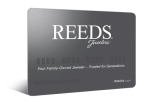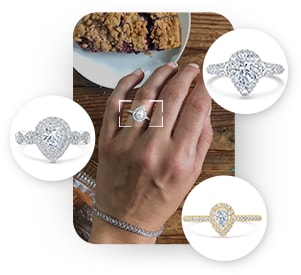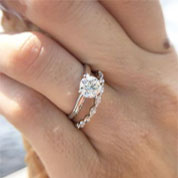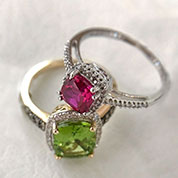This is a demo store. No orders will be fulfilled.

Engagement Ring Guide
A marriage proposal is a once-in-a-lifetime moment.
As soon as you decide you're ready to ask someone to spend forever with you, a million questions may run through your mind.
What will you say? What will they say? Where is the perfect location? Should you ask in private, or surrounded by friends and family? With so many details to consider, it's easy to feel immediately overwhelmed, but there are two very important details to remember.
The first, you've found the love of your life. All the bad dates are over. It's only joy and partnership from now on. The second detail to remember is before you pop the question, you get to find an engagement ring. Picking out a beautiful, sparkling token of your love is an exciting process that we can't wait to help you with.
Don't know where to start? That's okay. You've made the right first step to picking out an engagement ring. This is our guide to everything engagement ring related. We've got the answers to all your questions, plus helpful tips and answers to questions you didn't even know you had. Throughout this guide, we're going to help you understand choices like:
- price range;
- type of metal;
- type of gemstone;
- cut of the gemstone;
- the number of gemstones on the ring;
- ...and other tiny, but very important details!
We promise it will be fun. This isn't a study guide you're going to be tested on. It's a helpful guide so that you can create a magical moment the day you pop the big question. Through the years, we've helped thousands of couples start their journey of a lifetime by finding the right engagement ring. And we're confident that you'll find the perfect ring, too! Yes, even those of you who have no clue where to start.
Let's get to it!
First, a Few Questions to Narrow Down Your Options
At the beginning of your engagement journey, your options are wide open. You can literally have any ring you want at this point. Fun, right?
It can also be a little time-consuming. So let's talk about what kinds of rings your partner would really love. To help you out, we've come up with the five best questions to ask yourself or your partner so that you can get an idea of what they're looking for in an engagement ring:
- How often do they use their hands in the day?
- What part of the ring is most important: the gemstone, the band, or the setting?
- How would they describe their personal style?
- What colors do they wear most often?
- Do they want a ring that's more flashy, or more subtle?
Don't just stop there! Ask their family, their best friends, and any co-workers. Gather as much information as possible so we can really have some fun exploring the best options for you.
You can expect that your love may not know exactly what they want, or they may have an image in their head of what they want, not knowing that they have so many options available. Getting different opinions from the people who are around them every day can give you a fuller picture of what they gravitate towards and how they live their everyday life. Bring that information when you're ready to shop for engagement rings and let us lead you to the right one.
GET TO KNOW YOUR OPTIONS
Engagement Ring Settings and Styles
The first step is to decide what setting you want for the wedding ring. An engagement ring is made of three parts: the gemstone, the shank, and the setting.
- The gemstone is the diamond or gem.
- The shank refers to the band of the ring.
- The setting is the metal piece(s) that hold the gemstone in place.
Different settings can make the gemstone more prominent or more subtle.

Prong Setting
Great For Showing off the gemstone, easy cleaning, those who love a classic style
One of the more popular engagement ring settings is called a prong setting . In this setting, a single gemstone is the centerpiece of the ring. The prongs are usually V-shaped and hold the gemstone up above the band. Usually, the gemstone is held with four or six prongs. Four prongs show off more of the gemstone, but six is more secure.
The benefits of a prong setting are the visibility of the gemstone, the simplicity of design, the variety of gemstone cuts it can accommodate, and the timelessness of the look. One issue people find with prong settings, however, is the maintenance. Because the prongs often elevate the gemstone, it can easily get snagged, scraped, or bumped by everyday objects. If you're worried about damaging the gemstone, ask your jeweler to see low profile prong settings, or consider a diamond for the gemstone. Diamonds are one of the hardest materials and are very difficult to scratch, making them the perfect match for a prong setting.

Channel Setting
Great For Those with an active lifestyle and those who prefer small gemstones and/or a classic style
Another option to consider is an engagement ring with a channel setting. This is a secure way of setting smaller gemstones to be flush with the band surrounding the center gemstone. If you know your future fiancée loves a little extra sparkle and decoration, this may be the setting for you.
One drawback of an engagement ring with this setting is they are much harder to clean at home. With the different channels on the band of the ring, it tends to collect dust, dirt and other small particles, but as long as you take care of the ring, it shouldn't be too much of a problem. Plus, it's so beautiful and bright that you'll hardly notice a little dust!

Split-Shank Setting
Great For Adding extra sparkle, those who want a more unique style
The shank of an engagement ring is another word for the actual band. Most shanks are a round circle that surrounds the finger. However, some split into two separate shanks that surround a center gemstone on an engagement ring. These are called split-shank settings. Unlike the simplicity of a traditional band, split-shank settings offer beautiful, intricate designs that demand the attention of everyone in the room. Look through our collection of split-shank settings if you know your future fiancée wants something a little more unique to show off to all their friends.

Pavé Setting
Great For Making the gemstone appear bigger, those who prefer a simple design
Also known as a bead setting, a pavé setting describes the bands with small diamonds set into the band of the engagement ring. Typically, a jeweler will drill holes into the band, placing the small diamonds into the holes. To secure them in place, the jeweler will create tiny beads that act as prongs around each diamond.
Because pavé settings have been around and popular for so long, you can find it in contemporary or vintage styles. You aren't forced into a single style with pavé, you can get exactly what you think your love will love!
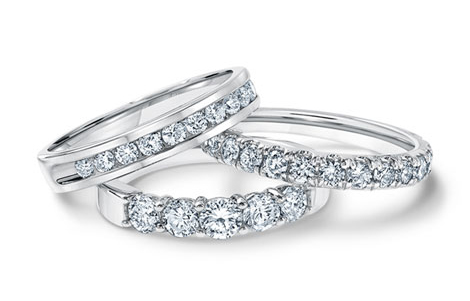
Diamond Band
Great For Matching bands, those with an active lifestyle, those seeking an easy shopping experience
Maybe you're in love with an incredible, yet practical, low-maintenance person and they aren't looking for a big diamond or one that is set prominently above the band. Perhaps their perfect engagement ring is one that could double as a wedding band if they wanted. If that sounds like the person you've fallen for, try an diamond band for your proposal.
Diamonds adorn the band for an understated, yet stunning look. You can choose to have them placed in prong, channel, or pavé settings. It isn’t overly flashy and doesn't attract immediate attention, but when you do look at it, you can see just how amazing its simplicity can be.
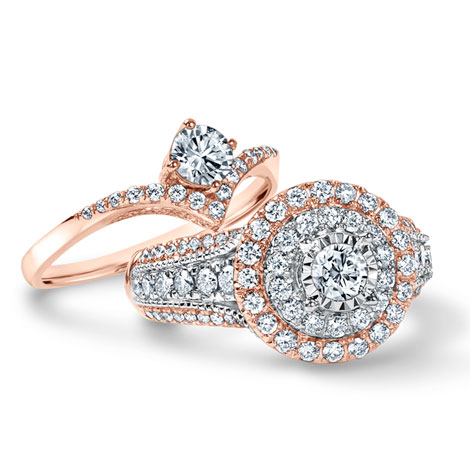
Vintage Inspired Setting
Great For Those looking for a unique design or who love timeless style
If you're worried about picking an engagement ring that will stand the test of time, consider choosing a vintage inspired setting.
A typical vintage ring features intricate band details such as filigree and milgrain.
- Filigree refers to the twisted threads of metal on the surface of the ring.
- Milgrain is a type of embellishment added to give a more antique look.
Together, these elements add charm and character you won't find in a simple band.
You can get a truly antique setting if you want to spend time searching, or you can get one inspired by the styles of each era from our collection.

Halo Setting
Great For Non-traditional gemstone shapes, added sparkle, smaller gemstones
A halo setting is another one of the most popular engagement rings for women. When a jeweler suggests a halo setting, they're referring to a placement of diamonds in a concentric circle (or square) around a center gemstone. If you're working with a smaller budget, a halo cut does an excellent job of enhancing the appearance of a smaller center gemstone, while also increasing the sparkle of the ring itself.
Beyond being beautiful, the halo setting is one of the few gemstone settings that complements irregular gemstone shapes. Pear-shaped diamonds, especially, work well in a halo setting. If you want something traditional with a little bit of unique flair, this is your first choice.

Three-Stone Setting
Great For Representing tradition, family members, adding gemstones later on
A three-stone setting is a favorite of many couples as each gemstone represents past memories, present times, and the future of their story. Before you ask, no, an engagement ring can never be too sentimental! With this setting, you have a lot of options to create a unique look for your lovely lady.
You can opt for gemstones that are all the same size, or gemstones that vary. You can make sure all three stones are the same or decide that the center gemstone is a diamond and the other two stones are a special gemstone.
GET TO KNOW YOUR OPTIONS
Engagement Ring Gemstones
Most people imagine diamond engagement rings when they envision a proposal. In reality, you can add any gemstone you or she would like. Depending on her style, your budget, and the design you like best, you might find that a diamond just isn't the right choice. No matter which way you go, it's good to know you have options.
Diamonds
If you really want to blow someone away with an engagement ring, put a beautiful, dazzling diamond front and center. Not only is it a versatile gemstone that will look perfect in every setting, but most people imagine diamond engagement rings when they think about marriage proposals.
But what should you be looking for when you choose the right one? We're happy to help you!
This is where the Four C's come in handy.
| Cut | The cut is what makes diamonds sparkle; the expertise of the diamond cutter greatly affects the sharpness of the cut and its light refraction. |
|---|---|
| Clarity | Almost all diamonds will have some sort of imperfection, but the clearer the diamond, the higher the quality. |
| Color | Each diamond is classified on a scale from D to Z. A D diamond is 100% colorless, while a Z diamond is yellow or brown. |
| Carat | A diamond's weight is measured in carats. The most common sizes are ½, ¾, 1, 1 ½, and 2ct diamonds. |
First, you want to look at the cut. This refers to the shape of the diamond. You have a wide variety of cuts to choose from, but the most popular are the round cut, oval cut, and cushion cut.
Obviously, the best way to know exactly what they want is to just ask, but if you want to make the engagement ring a complete surprise, here's a good way to decide which would be the best style for your better half:
- The round cut is the most popular cut. It's best at showing off the color and clarity of the diamond, as there tends to be a lot of facets in a round cut diamond, making it shine as brightly as possible.
- The princess cut is a fun and unique alternative, with more of a square shape.
- The cushion cut is similar to the princess cut in that it usually comes in a square or rectangular shape, but it has rounded corners to give it the appearance of a pillow. This truly timeless cut will look good no matter what decade your partner is wearing it.
- The pear cut features the best of both worlds. It is a combination of a round cut and a marquise cut with a tapered point on one of the ends. Tip: the narrow tip end should always point towards the hand (or the heart).
- The oval cut is an adaptation of the popular round cut. The diamond is elongated in the oval cut, so it's great for anyone with longer fingers.
- The marquise cut is rare, but breathtaking. Also known as the "football cut," a marquise cut diamond is elongated like an oval cut, but with narrow, pointed tips.
- The radiant cut is a square- or rectangular-shaped diamond with trimmed corners. Instead of four sharp corners, a radiant cut diamond has eight sides with more obtuse corners.
- The emerald cut is a rectangular, step-cut diamond. Step cuts show less fire than a brilliant faceted diamond, such as a round diamond, but emit more white light or brilliance.
After cut, you want to look for clarity. Almost all diamonds will have some sort of imperfections, but the "cleaner" the diamond, the higher the quality. To get a full understanding of your diamond's quality, check the grading report. A grading report will tell you about the diamond's unique characteristics, the grade of the diamond, and helps verify the value. A diamond grading report is not necessary, but highly suggested.
Next, look at the color of the diamond. Each diamond is classified on a scale from "D" to "Z." A "D" diamond is 100% colorless, while a "Z" diamond is yellow or brown. Perfectly colorless diamonds are very rare and valuable; it's good to go for the near colorless range so it appears colorless face-up. The near-colorless range is G through J in color. Color is also something included in the grading report.
Finally, decide on the carat, or the size, of the diamond. It may surprise you to learn that this is not the best way to determine how valuable a diamond is, but it is a practical factor to consider when choosing the perfect engagement ring for your fiancée.
Colorful Gemstones
Maybe your future fiancée isn't interested in diamond engagement rings. Maybe she wants her engagement ring to be a little more unique. If that's the case, try one of our other gemstones. REEDS Jewelers offers over 20 alternative gemstones that you can add to your engagement ring, ranging from dark onyx stones to light amethyst stones.
We've found that some of our more sentimental couples enjoy picking gemstones for their engagement rings rather than a traditional diamond. You can find the gemstone that represents the month you two met, the month of your engagement, or any other important date to you. Maybe you have children and want to honor them in a three-stone setting with different gemstones. We love to make that kind of creativity come to life for you!
GET TO KNOW YOUR OPTIONS
Engagement Ring Bands
Once you've decided on the engagement ring setting, the gemstone, and the cut, you'll want to focus on the metal of the band.

Gold
Gold is the standard for engagement ring bands. It's classic, impressive, and gives an excellent contrast to the light sparkle of a diamond. Decide if you want a rose gold, yellow gold, or white gold ring. Each, of course, creates an entirely different look and style.
For example, rose gold pairs well with a morganite gemstone, while a diamond paired with white gold provides a classic look. Yellow gold, on the other hand, can really make an emerald or an amethyst gemstone pop. The easiest way to know which elements of the ring to prioritize is to just ask what your partner wants. Think of it as a collaboration project!
If you're not sure what color gold they'd prefer, sneak a peek into their current jewelry collection. If they have a preference for metals, it will show in the accessories they already own. You want to make sure that an engagement ring matches most of the current jewelry without looking like all the other pieces they own.
You may also want to take inventory of their wardrobe. If they have a bunch of cool tones, you may want to lean towards white gold, but if they wear warm colors like reds and oranges, rose gold and yellow gold will really pop with whatever outfit they choose. Remembering these tiny details will all be worth it when you see the look of pure joy on their face the moment you propose!
Gold, like diamonds, does range in quality. For example, a 10 karat gold band means that there's just over 41% pure gold in the band. By contrast, a 24 karat gold band means the band is pure gold. 14 karat bands will be made of just over 58% pure gold and 18 karat gold is right at 75% pure gold. The higher the gold content, the more the band will be worth and it can be scratched more easily, as gold is a softer metal. If you can't afford a 24 karat gold band just yet, that's totally fine, you have a lifetime to improve on this engagement ring. Get what you love (and what you can afford) now, and upgrade as an anniversary present.
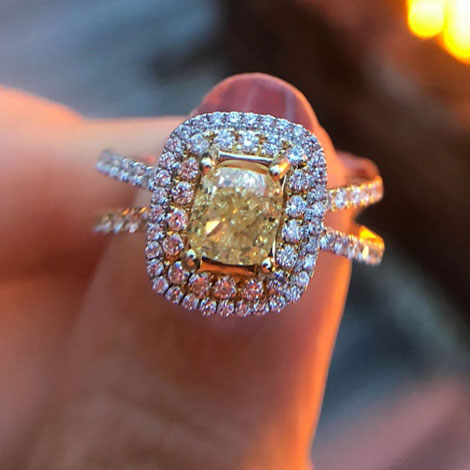
Alternative Metals
You can also mix and match metals to create a completely unique engagement ring design. Each jeweler will be different, but most will carry a wide variety of metals to accommodate the woman that prefers a non-traditional look.
Other metals might be necessary if you have skin allergies, as well. Up to 17% of women (and 3% of men), for example, are allergic to nickel, which can be found in some white gold rings.
Fortunately, there's a whole world of metals to browse! Choose from platinum, cobalt, steel, and titanium for engagement rings. Especially if you're hoping to marry someone who wants a sturdier style, a more heavy, durable metal might make a better fit for them. Just keep asking us questions and we'll be able to point you in the right direction.
What Will Look Good on Their Hand?
Just like a wedding dress or a chic suit, everyone wants their engagement ring to look like it was made specifically for their hand. Even if you don't have the budget to make it custom, there are ways to determine what ring will look best on the hand. Here are some details to look out for:
Long Fingers
Long fingers are great for going bold. Many styles will look good, but especially princess-cut or round-cut stones on a prong setting with a wider band.
Short Fingers
For short fingers, it's important to pay attention to the cut of the stone. To really make it look great on the hand, pick a gemstone with either a round shape or an elongated shape. Try a pear-shaped or an oval diamond in a tension setting with a thin gold band. It'll look flawless.
Thin Fingers
Thin can look awkward carrying big gemstones and heavy metal bands. If you're shopping for someone with particularly slender fingers, consider a smaller gemstone on a wider band. Maybe try a white gold eternity band with sparkling diamonds.
Wide Fingers
Wide fingers give you so much room to make a statement. Wide fingers can make any engagement ring look good, as long as it's sized right! Try a rectangular cut diamond in a halo setting to really highlight their finger.
What Really Matters In an Engagement Ring?

With all these options and decisions, we understand if you don't know what to prioritize. Remember, this process is daunting for everyone. Most people have never done this before, so they have all the same questions that you do.
Also, don't feel like you need to do it alone. Some couples find it fun to go through the process together. If you think she would enjoy herself, ask her to come along with you to give you ideas of what she loves. Take notes on some of her must-haves and the details she can live without. When you feel confident you know what she would like, talk to one of our jewelers and we'll make sure you find it.
Setting a Budget for Your Engagement Ring
The last step — contrary to popular belief — is determining the budget for your engagement ring. How much should you really be spending on a single ring? The real answer is it's different for everyone. Only you know what your budget will allow. Tradition says that you should spend two to three months worth of income on the engagement ring, but that doesn't mean it's a rule. If you want to know where most people land, the average engagement ring costs around $6,350.
If the prices intimidate you, we understand. One helpful tip is to try to imagine the ring as an investment. It's a piece she is going to wear every day of her life, so spending a little extra up front to ensure that she absolutely loves it doesn't seem that bad.
Of course, there are ways to avoid a price tag that high, if you need to.
First, try adjusting the carat size of the diamond. For example, a diamond that is 1.8 carats is much more cost effective than one that is 2 carats and the size difference is hardly noticeable.
You can also compromise on the clarity of the diamond in order to bring down the cost. The higher the clarity, the more it's worth (and the more it sparkles), so while this isn't everyone's first choice, it is an option if you're looking for a more budget-friendly ring.
Exploring different metals for the band is another a great way to bring down the price of your engagement ring. Platinum is a very expensive metal compared to gold, while silver is more cost-effective. Some couples prefer to spend most of their money on a diamond with better clarity in the right size, knowing that they can upgrade the band when their budget allows.
If you just know that you've found the ring your partner is supposed to wear, but it's out of your price range, we can also help with that. We offer special financing options to our customers for that exact reason. Don't let price stop you from getting the proposal of your dreams. Learn more about our financing options here.
No matter which option you choose, we will work with you to get the most out of your budget. Additionally, REEDS offers a 30-day, risk-free return policy, so if the ring isn't what you had in mind, you have 30 days to make the final decision. You can learn more about our return policy here.
The Final Touches

Now you've made all the decisions: you've picked the perfect setting, the gemstone that represents who she is and what she loves, and a band that will complement her personal style. The only thing left to do is pick the right size.
There are a few ways to find out what size your partner's finger is, but the easiest way is to just ask. Have her come with you to the showroom during one of your first visits to get sized. Some women prefer to have their rings nice and snug on their fingers, while others find that to be claustrophobic.
To add even more complications, fingers can vary in size depending on the time of day or the season. Cold temperatures tend to make your fingers smaller, while warmer temperatures tend to bloat fingers. You want her engagement ring to fit no matter what the season, so your best bet is to make sure the ring can't easily slide past your partner's knuckles, to avoid it sliding off in the colder months. (A lifetime care plan is also a wise investment!)
Some people want their proposal to be a complete surprise, so asking her to come with you is out of the question. In that case, investigate her current ring selection. If you can, bring one of her favorite rings with you to our showroom so we can get her size. Or bring her family and friends with you as you shop. Likely, one person in her life has purchased jewelry for her before and can help you find the right size. Sometimes mothers and daughters have similar hand sizes, so her mom can be a great resource in a pinch. Plus, it's an incredibly fun bonding experience when you all work together to find the perfect engagement ring for the girl you love.
Making An Engagement Ring Last
After you've spent the time learning about engagement rings, working with a trusted jeweler to buy a high-quality, beautiful ring she'll love immediately and forever, you need to know how to protect your investment.
If you'd like to get the engagement ring insured, start with a statement of value. Find a jeweler who is trusted and has all the right credentials. The last thing you want is an inflated statement of value that your insurance company won't honor should anything happen to the ring.
Next, get insurance for your ring through your homeowner's or renter's insurance if that's easiest for you. You can also find an independent insurance company who specializes in jewelry. The choice is really up to whatever is easiest for you.
Lastly, make a habit of getting new statements of value every year. The value of your ring will likely increase as time goes on, so keep updating your insurance plan to keep yourself covered!
Another important note on making your engagement ring last is keeping it clean. Think about all the things you do with your hands on a daily basis, all the dust and particles that get collected in the tiny cracks of an engagement ring. Keeping it clean isn't just about the sparkle, (although the shinier, the better for some women) it also keeps the quality of the ring up. Wear and tear of everyday life won't ruin the ring as long as you constantly keep it clean and in good condition. The best way to clean a diamond ring is with a jewelry cleaner, warm water, and a soft bristle brush. If you do not have a jewelry cleaner, a tiny bit of mild soap and a soft bristle toothbrush works well too!
One Last Tip

The last thing to remember is that this should be a fun process. You're starting your future with the love of your life. You're giving them a gift that they will wear every day for the rest of their life. That's a big moment! Have fun with it and make it just as memorable for you.
Along the way, we are here to help you. Whether you're just browsing options on our website, or it's your last visit to our store to pick up the engagement ring, we're here to answer questions, work with you, and celebrate with you! Even if you can't make it into one of our stores, give us a call at 844-REEDS-40 or order online. We promise to deliver the same unforgettable experience no matter how you find us!
This is a moment you will remember forever and a process that you will only do once. Soak it in, learn as much as you can, and enjoy the first step to the rest of your life.


